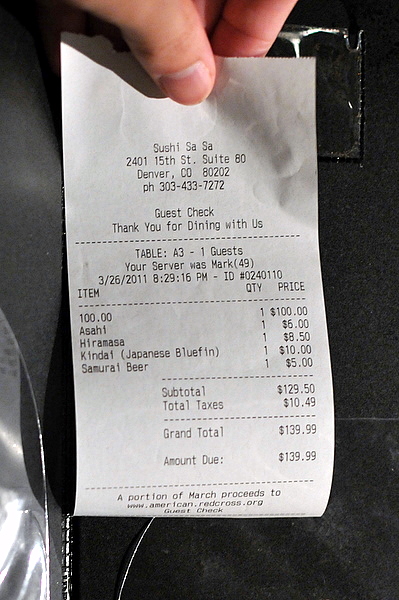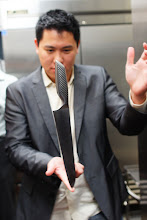2401 15th St #80
Denver, CO 80202
(303) 433-7272
During my previous visit to Denver, I was exceedingly impressed with with the quality of Sushi Den. The quality of fish would have placed the restaurant in the upper echelon of sushi restaurants in LA, no mean feat considering the restaurant is in a landlocked state. This time around I contemplated going back, but the cessation of their Denchu room negated my impetus to return. Instead I decided to try Sushi Sasa, which many consider to be as good as Sushi Den.
Chef Wayne Conwell opened Sushi Sasa with the lofty goal of being an "evolution of sushi" integrating influences from "around the world" with the "rigid traditions of Japanese cuisine." Still Conwell might be the only chef in Denver who can pull it off. Prior to opening Sushi Sasa, Conwell worked at Japon and ironically, Sushi Den. Before that he worked for one of the great masters of new-style Japanese cuisine, Masaharu Morimoto.
Eagle Rock Oysters
Eagle Rock oysters are a species of West Coast oyster from Puget Sound in Washington State. The oysters are medium sized and posses a marked salinity and subtle essence of nori, the perfect tie in to the tart ponzu and pickled daikon.

Tuna Crudo - shiitake vinaigrette, mozzarella, kalamata olives
Despite being such a ubiquitous sushi and crudo fish I find effectively pairing accompaniments with tuna to be exceedingly difficult. The flavors of the vinaigrette, cheese, and olives never seem to come together and the resulting discord draws attention away from the fish itself.

Ankimo Sashimi (Monkfish Foie Gras) - miso dressing, homemade brioche, foie gras, quail egg, and sturgeon caviar
This dish was a mix of new and classic; the miso dressing and caviar were familiar pairings while the foie gras and egg were not. The foie gras was too similar to the ankimo, they even call it monkfish foie gras for crying out loud, and didn't add much to the dish. The quail egg on the other hand gave the dish a slickness that helped balance the dense body of the ankimo.

French Onion Style Black Cod Soup - nori rice crouton and melted gruyere
The sharp melty gruyere and potage of sweet caramelized onion are textbook French cuisine. The black cod and nori are seamlessly infused into the soup giving it a refined umami-laced sapor while the rice adds a comfortable heartiness. Finally we have an effective example of the melding of culinary traditions that Conwell aspires too.

Chilean Sea Bass - white truffle oil, jade pesto
Even now the jury is still out on this dish, I enjoyed the acidic tang of the pesto but found the truffle oil too heavy for the delicate fish. The fish itself was superb, the succulent translucent flakes of sea bass threatening to disintegrate under the touch of my chopsticks.

Alaskan Black Cod - gobo, white miso
I was a bit surprised to see Nobu Matsuhisa's oft-copied signature black cod with miso in its unadulterated form with flavors of pure sweet miso, fatty fish, and charred skin. Like the sea bass, the black cod was a semi-translucent but I detected a firmer texture on the black cod. Given how often I hear black cod suggested as a substitute for Chilean sea bass, I appreciated having them side by side.

Angus Choice Tenderloin - grilled then broiled in uni wasabi butter
I really could have done without this course. The meat felt unduly tender and the uni and wasabi components of the butter were nonexistent. The result was a tough, boring piece of meat.

Sushi - Croatian Otoro, Madai, Shima Aji, Scottish Salmon, Anago
It comes as no surprise that demand for Northern Bluefin Tuna has depleted fish stocks worldwide with the Mediterranean being particularly hard hit. Today Croatian Tuna is produced by Kali Tuna whose founders worked with the scientists in Australia and Japan who were responsible for Kindai. The result is farmed tuna hatched from eggs rather than juvenile tuna captured in the wild and fattened for consumption. Regardless of the production method, the Croatian Otoro was undoubtedly the star here, a flawlessly rich example of fatty tuna. Unfortunately I was so taken aback by the Croatian toro, I forgot to take more detailed pictures of the remaining fish. The Madai and Shima Aji were quite good, and all around the fish quality was perhaps just a hair under what I would expect from Mori or Zo. Where Sasa falls short is on the rice which lacks the refinement and attention to detail that I recently experienced at Mori.

Kindai
Given the scarcity of Kindai tuna I find myself amazed that Sushi Sasa managed to procure some. When I first heard about this sustainably farmed bluefin, only three were shipped to the States per week and that alottment was pretty much reserved for the creme de la creme in the culinary world; restaurants like French Laundry, Le Bernardin, L2O, Manresa, and Masa(NYC) to name a few. Still this had the deliciously oily flavor that I've come to associate with Kindai, not quite as rich as toro but noticeably fattier than wild bluefin.

Hiramasa
The hiramasa was what I expected, much more expressive and nuanced than hamachi but with that same familiar flavor profile.

Dessert - Wasabi Tiramisu, Tempura Cheesecake, Chocolate Mousse Cake
At first glance the desserts seemed very ham-fisted and hastily put together, but the flavors actually worked surprisingly well. This was particularly true of the wasabi tiramisu, where the subtle undercurrent of heat from the wasabi was just enough to lend the dessert a delicious savory depth.

So did Sasa accomplish everything it set out to do? Not yet, but Chef Conwell is off to a very strong start. At times the combination felt forced or crude, but the execution was generally solid. Indeed Sasa is the only Japanese within striking distance of Sushi Den. If Chef Conwell is able to refine his technique I could foresee Sasa dethroning Den as Denver's top spot for sushi.

Wednesday, April 13, 2011
Sushi Sasa - 03/26/2011
Subscribe to:
Post Comments (Atom)

2 comments:
I'm visting denver in a few day, and I'm haping you able to give me some insider help.
Between sushi sasa and sushi den, which will be your top pick.
Who has better omakase?
Base on what I know both claim they get their fish directly from Japan, are ether one quality to the par as Urasawa?
Do ether one has real wasabi?
Thanks
Dason,
Its been quite some time since I've been to Sushi Den. I think Den might have better sushi but Sasa definitely has better cooked stuff.
Both get their fish from Japan but they are nowhere near the level of Urasawa.
I don't recall real wasabi but they may have it available for a price.
Post a Comment